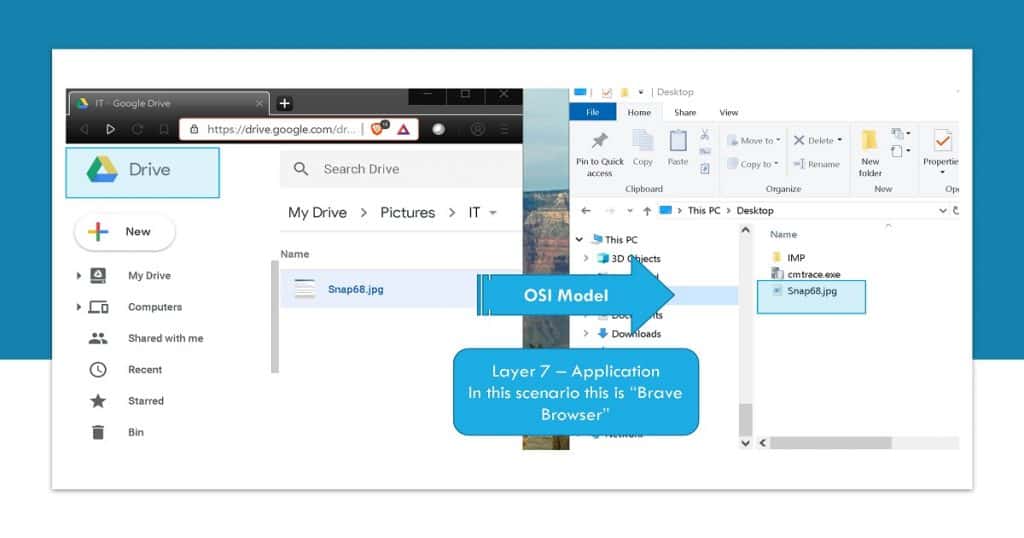Let us learn Desktop Support Network Troubleshooting Tips for Beginners. This post is a continuation of my old post, “How to Learn Desktop Support Engineer Skills.”
Desktop support engineers are an integral part of the IT support world. In the IT support world, the real heroes are Desktop Support Engineers.
In this post, you will learn troubleshooting skills for IT support with the help of the OSI Model (Open Systems Interconnection).
[Related Post – IT Career Options IT Pros Vs. DevOps Vs. Developers]
IT Support Troubleshooting?
I always feel that understanding the OSI model helps develop and learn troubleshooting skills in the IT world. If you have a better understanding of the OSI model, it will be easy to perform troubleshooting.
The OSI model helps to characterize and standardize network (in a conceptual or theoretical way) communication between different software/applications and hardware components. There are seven (7) layers involved in the OSI model. The following are the 7 OSI layers:
- Layer#1 – Physical Layer
- Layer#2 – Data Link Layer
- Layer#3 – Network Layer
- Layer#4 – Transport Layer
- Layer#5 – Session Layer
- Layer#6 – Presentation Layer
- Layer#7 – Application Layer
The TCP/IP model is used in real-world scenarios. The OSI model is a more theoretical model to understand network communication in a better way and learn IT Support troubleshooting. More details in the below video and resources section.
Real-world Scenario of OSI Model?
When you want to transfer files from one computer to another using network shares (or Onedrive – Google Drive). The network transfer is completed using a conceptual method of OSI model 7 (seven) layers.
You will get more details about 7 (seven) layers in the below sections.
The OSI model divides the complex task of the computer to computer communications into a series of stages known as layers. An OSI layer serves the layer above it. And the same layer is served by the layer below it.
I have copied a file from Google Drive to a local Windows 10 machine in the following example. I used the Brave browser (application 1 & 2) and downloaded the file to the Windows 10 device. In this data transfer example, you can relate the 7 (seven) layers of the OSI conceptual model to understand IT Support scenarios.

Layer 1 – Physical Layer
Transmission and reception of unstructured raw data between a device and a physical transmission medium. As the name implies, the physical layer is all about the Bluetooth, Optical Cable, Ethernet cable, and USB.
Hubs and Repeaters are also considered devices that function at the physical layer.
- Network Cables
- Bluetooth
- Optical Cable
- USB
- Hub
- Repeater
IT Support Tip – All the cables plugged in, or is data copied to USB correctly?
Layer 2 – Data Link Layer
As per various articles I read, the Data link layer is the most complex layer of the 7 (seven) OSI Layers. The data link layer in the OSI model defines the protocol to establish and terminate a connection between two physically connected devices.
IT Support Tip – Source and Destination MAC addresses are added to the data in the Data Link Layer.
There are two sub-layers as part of the Data link layer. The following are two sub-layers of the Datalink.
- Medium access control (MAC) layer
- Logical link control (LLC) layer
The devices which are acting the part of the Datalink in your real-life experience:
- Switches (Layer 2)
- Bridges
Layer 3 – Network Layer
The network layer is the one that decides the route of your data transfer from one node to another node. The physical device attached to this network layer in the OSI model is network “Routers.”
- Layer 3 Switches
- Routers
IT Support Tip – Source and Destination IP addresses are added to the data in the network layer.
Layer 4 – Transport Layer
The transport layer in the OSI model takes care of data transfer between different networks. TCP and UDP are the most common data transfer protocols various applications use.
The TCP/UDP protocol details are added along with the source and destination port numbers at the Transport Layer (IT Support Tip).
Layer 5 – Session Layer
The session layer of the OSI model provides the mechanism for opening, closing, and managing a session between application processes. One example of the session layer in the IT Pro world is RPC (remote procedure calls).
Start, Stop, and Maintaining the Sessions between the endpoints are managed by Session Layer (IT Support Tip).
Layer 6 – Presentation Layer
The presentation layer formats the data so that the receiving application can understand the data. One example is SSL (encryption) communication requirements for an application.
The presentation layer helps to Encrypt or Decrypt the data for the receiving application (IT Support Tip).
Layer 7 – Application Layer
The application layer is where application and user interaction will occur.
Some real-world examples are end-user applications like outlook, File Explorer, Chrome, or some other applications using different protocols HTTP (web communication), HTTPS (Secured web communication), and SMB (file transfer).


Hello Anoop,
I am starting my career as Desktop support engineer, Can you please let me know how to start from scratch to make my skill set strong as per the market.
Hello Anoop,
I am starting my career as Desktop support engineer, Can you please let me know how to start from scratch to make my skill set strong as per the market.
I would try https://www.anoopcnair.com/learn-desktop-support-engineer-skills/
simply and very easy to understand..